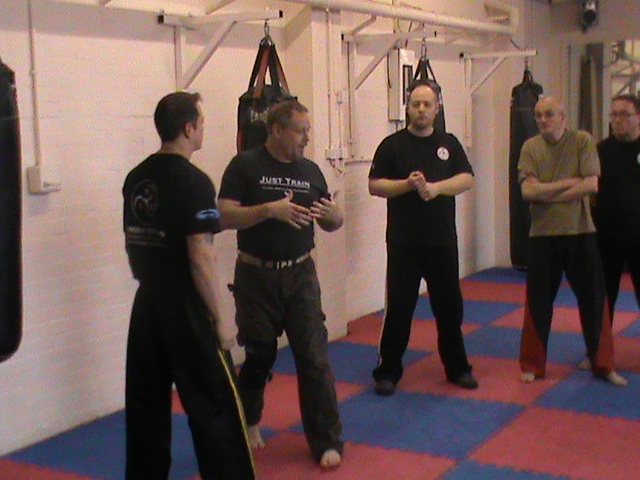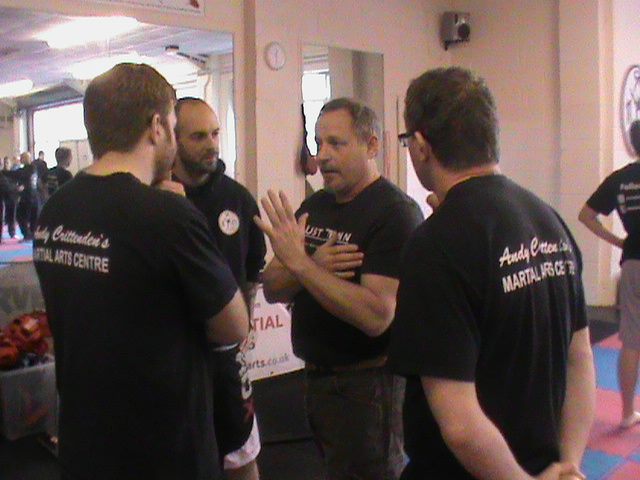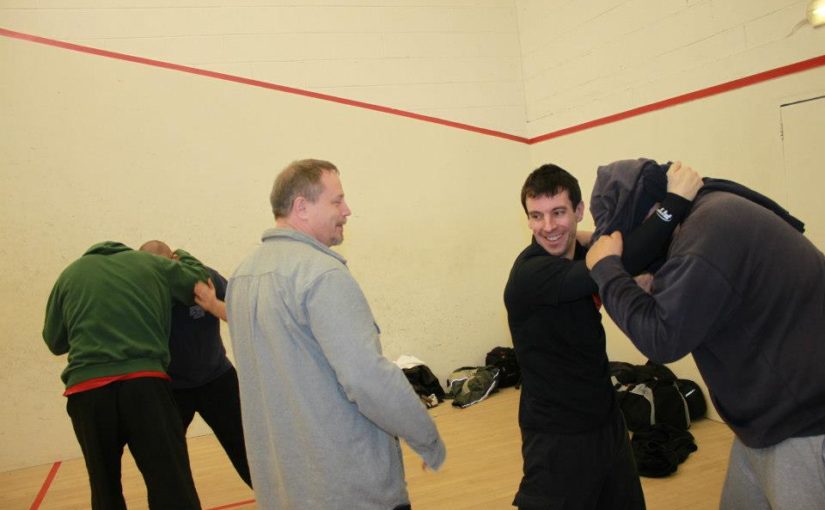Editor’s note: In last month’s issue, Erik Kondo wrote a wonderful article on the “12 Principles of Conflict Management”. One of the founding principles of CRGI is that we want our readers and students to see that we challenge and disagree with each other all the time. That there can never be “experts” in a field as complex as conflict. We challenge each other because we all know that being sure is complacency, and complacency is the first step on the road to failure. Our discussion can be your discussion too. Read everything critically, do not just swallow and regurgitate the last thing you read, however cool. So in this issue both Rory Miller and Garry Smith respond.
In the April issue of Conflict Manager Erik put out a great article on the 12 Principles of Conflict Management. He listed 12 principles that all successful conflict managers use:
- Respect (Tolerance, Empathy, Consideration)
- Clear Communication (Minimal misunderstandings, Directness)
- Appropriate Enforcement (Just-Right for the situation)
- Truth (Actuality, Reality)
- Knowledge (Deep understanding)
- Dynamic Problem Solving (Critical Thinking, Neo-cortex utilized, Situation specific analysis)
- Evolution (Constantly evolving and changing, Double Loop Learning)
- Continuum of Responses (Spectrum, Scaling, Progressive/escalating use of force)
- Control of Emotions (Limbic system controlled)
- Trade-offs (Cost/Benefit analysis, Give/take, Negotiation, Compromise, Cooperation)
- Open-minded (Responsive to feedback, Open to differing viewpoints)
- Accountability (Responsibility, Agency, Acceptance)
It is easy for a simple list to become a dogma. It is also dangerous and these principles are not just words, they require a depth of understanding in order to utilize them effectively and to know when your own principles are being used against you.
During our discussion via email Garry suggested that we could look at this, literally as though we were having our eyes tested. I have no idea what he means by this, so I’m eager to check out his article. I do, however, know that we all see things differently and it’s a grave mistake to assume that different=wrong.
1: Respect (Tolerance, Empathy, Consideration)
Respect based on understanding is important. Sympathy, not empathy (or is it the other way around? I get those confused). It is fine to understand other’s feelings or point of view but do not get sucked into them. We have, in this culture, been taught, largely as unthinking dogma, that all points of view are equally valid, and that since tolerance is a virtue, unlimited tolerance must be saintly.
That’s not just wrong, it is dangerously naïve. If you support unlimited culturally diversity, you must also support female genital mutilation. You simply can’t have it both ways. So understand that everyone has limits on their tolerance. If they don’t there can never be a negotiation, just a drawn-out surrender on all points. Without boundaries you will stand for, your only possible conflict management strategy is to beg and hope that the other party, for their own reasons, will drop you a scrap. To have any depth of game, you must have firm lines on what you personally will not tolerate. And if you are tolerant on many issues, watch for where others use your tolerance to manipulate you for their own gain
2: Clear Communication (Minimal misunderstandings, Directness)
Because of my personality, I agree with this very much. The world becomes very smooth and simple when “yes” means “yes” and “no” means “no.” That said, I’m mature enough to understand that this is not the norm for many people.
In many cultures, directness is considered rude. In some subcultures, especially many of the criminals that I dealt with, stories are often told in a circular manner, slowly building up to the point (See A Framework for Understanding Poverty: A Cognitive Approach by Ruby K. Payne, Ph.D).
You have to understand cultural nuances before you can define what clear communication even is.
3: Appropriate Enforcement (Just-Right for the situation)
Realistically, enforcement belongs at the very end of the list. But I’m following Erik’s lead here.
Understand this deeply. Negotiation only works, negotiation doesn’t even exist, except for the threat of what will happen if negotiation fails. You never do hostage negotiations without a tactical response on standby and a country without an army may make themselves feel important by mediating a treaty… but negotiation without an alternative is begging.
And understand as well that rules, policy and law have no existence other than to the extent that they are enforced. Without enforcement, they are imaginary. Just sympathetic magical spells cast by modern shamans. Only believers in the cult are bound by them, and only to the extent that they choose to be bound.
4: Truth (Actuality, Reality)
This takes skill. Simply, very few people have practiced distinguishing facts from conclusions. Feeling sure about something is no indicator of accuracy. Because people conflate emotion and fact, very few disputes are about reality, but about interpretation. If you have not practiced, you will do this as well, and be part of the problem.
5: Knowledge (Deep understanding)
This topic can go as deep as you are willing to take it. Being a subject matter expert in the subject under dispute is valuable. Do you want an electrician mediating between two surgeons on the best way to do a knee surgery?
But you can be skilled at the mechanics of resolving disputes themselves and dissect the disagreement even if you don’t understand the underlying problem. But that takes skill, humility (because the solution will not come from you and you have to accept that), and sensitivity (to recognize the change in attitude when the disputants approach agreement.)
And understand the difference between memorized trivia and understanding. The ability to spout facts is often misinterpreted as understanding those facts. Don’t fool yourself or allow yourself to be fooled by others.
6: Dynamic Problem Solving (Critical Thinking, Neo-cortex utilized, Situation specific analysis)
Ideally, this is where the other twelve principles lead. Rational thought solves problems. Emotions applied to problems often end in either a dominance/submission dynamic (that’s what the limbic system likes) or in overt violence.
But critical thinking takes skill. The best exercise (and test of skill) that I know: if you are rational, you can convincingly, logically and sympathetically argue all sides of an issue. If you can’t, you are working from your limbic system.
7: Evolution (Constantly evolving and changing, Double Loop Learning)
Growth and evolution is the hallmark of all effective people, not just conflict managers. For continuous growth, you must be honest about what has worked and failed and why. Many conflict managers use and teach the tactics they like to use, which may not be the tactics that work best.
In the moment, especially in a tense situation, you must constantly assess what you are doing and adapt. A good manager can change tactics as soon as she sees the signs things are going downhill. A poor conflict manager stays on “proven” strategies even when they are clearly not working.
8: Continuum of Responses (Spectrum, Scaling, Progressive/escalating use of force)
Conflict is a big subject. In the civilized world, skill at negotiation is often enough– you have access to lawyers and, if necessary, police to enforce agreements. But understand that if your skills don’t extend from the immediate persona you project without saying a word; to your ability to argue, trick, negotiate, debate, and command; to your ability to use force from pushing to deadly force; then your skills are incomplete. There are entire levels of conflict that you cannot manage.
Do not arrogantly believe that a very high skill at one type of conflict will translate to any skill at all at a different level. And within the verbal skill set (reference deep understanding) do not believe that your skill at dealing with social problems will help dealing with someone working from an asocial perspective. The skills will not only backfire, they will be used against you.
9: Control of Emotions (Limbic system controlled)
For most people, the default wiring is to assume that any conflict with another human being is a social and/or emotional issue. And we have a tendency to deal with emotional issues from an emotional perspective. Are you smarter when you are angry? Afraid? In love? Do we have any evidence whatsoever that any emotion makes you better at solving problems?
10: Trade-offs (Cost/Benefit analysis, Give/take, Negotiation, Compromise, Cooperation)
The Win-Win solution is set up as the ideal solution in any negotiation. A pure win-win, where everyone gets exactly what they want, is rarely possible. Anything you gain comes at a cost to someone else. A pure win-win would never need to be negotiated, just the possibility pointed out.
Which means you must have a clear idea of what you need and what you want. A clear idea of what you can and cannot sacrifice for what you want. And understand everyone else’s motivations just as clearly. Your ability to manage the conflict will lie almost entirely in your ability to navigate between these edges (gains and losses, acceptable and unacceptable) for all parties.
11: Open-minded (Responsive to feedback, Open to differing viewpoints)
Closed minds don’t grow. Learning is a lifetime activity and I would argue the primary purpose of being a human. That said, it’s entirely possible to learn crap. An open mind with no filter is just as useless, and more dangerous, than a completely closed mind.
All of these principles inter-relate. Your understanding of knowledge, actuality and– above all –critical thinking must temper your tendency to open-mindedness. Listen with an open mind but accept only with critical, rational judgment.
Without mechanisms to test, evaluate, and accept or reject new information a naïve open mind is not just a problem, but a tool that can be used and controlled by people who will not have your best interests at heart.
12: Accountability (Responsibility, Agency, Acceptance)
It is not enough to be able to negotiate or debate or even fight. You also need to be able to identify and measure success or failure. You need to have a mechanism to follow up and make sure the problem resolution is holding. You need to be able to do something if the situation is disintegrating
Without these mechanisms, any solution to any conflict is merely a ritual. The words are said and the treaty is signed…and it will forever be a piece of paper and no more.
You must develop follow-through and in most cases you must grow a reputation for follow-through or else people will be happy to resolve conflict with you, fully confident that they will have free reign as long as they pretend to agree.
Remember, each person in a conflict wants certain things and they want those things at minimal personal cost. If they know or learn that you are satisfied with the appearance of agreement, they will be happy to give you that. The cost of pretending to agree or even to acquiesce is minimal. And the gains from just doing what they want after you have accepted the agreement can be immense. Actions always trump words and without the action of follow-through, any agreement is nothing but words.
In conclusion:
Even this only scratches the surface of these principles. To be good at conflict management or to be skilled at any complex skill is a matter of depth and breadth. There are no simple answers, no one-to-one correspondences. If I were to simplify the list, I would say being a successful conflict manager rests on:
- Clear goals. You must know what you need, what you want and what you would like.
- Clear parameters. You must know what is absolutely unacceptable, what you wouldn’t like and what you could live with.
- Awareness. You must be aware of these within yourself and just as aware of the goals and parameters of the other people involved.
- Assessment. You must have skill at reading other people and the situation so that you can know what is working and what is failing. Over the long-term, you need a mechanism to apply this to continuously refine your skills.
- Adaptability. On many levels.
- Follow-through.




